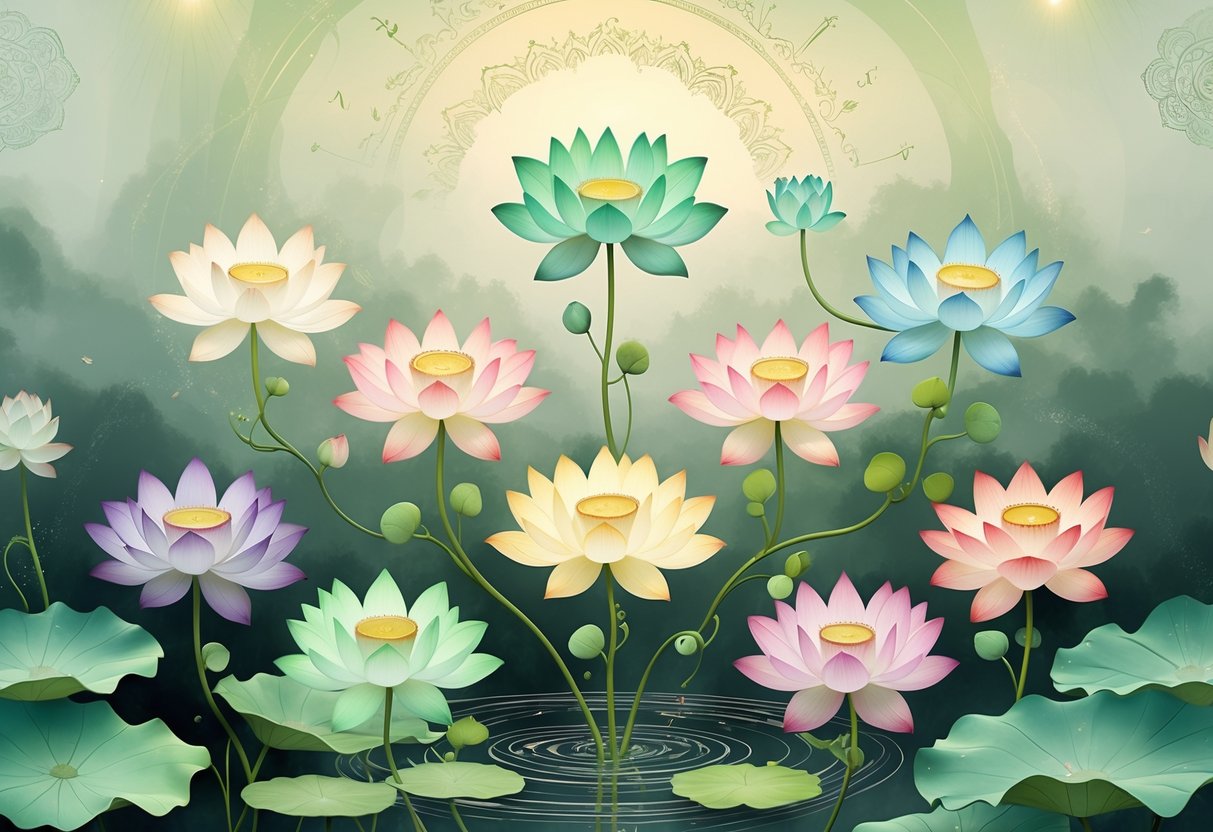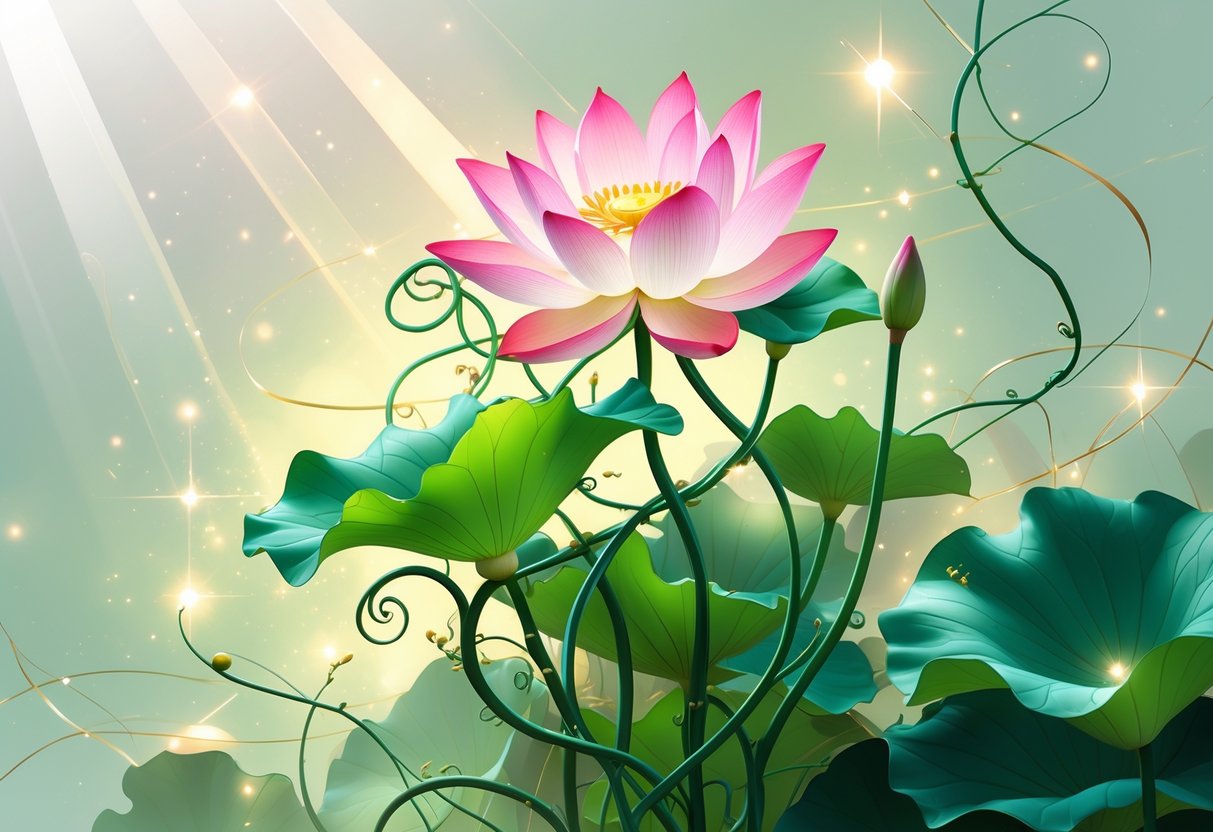The lotus vine flower holds rich spiritual meanings that have inspired many on their journey toward self-discovery and inner peace. It symbolizes purity, resilience, spiritual growth, and transformation, guiding individuals to rise above challenges and embrace renewal. This flower’s ability to bloom beautifully despite growing in murky waters serves as a powerful reminder of strength and hope.

Its symbolism spans various cultures and spiritual traditions, often representing a connection to the divine and the unfolding of higher wisdom. The lotus vine flower invites people to reflect on their own growth and the cycles of life, encouraging a deeper understanding of themselves and the world around them.
Exploring the eight spiritual meanings of this flower offers insight into how it can inspire personal evolution and healing. This knowledge can serve as a guide for anyone seeking clarity, balance, and a fresh start in their spiritual or everyday life.
Key Takeways
- The lotus vine flower represents resilience and inner strength.
- It is a symbol of spiritual growth and connection.
- The flower inspires transformation and new beginnings.
Core Symbolism of the Lotus Vine Flower

The lotus vine flower carries deep meanings connected to purity, growth, and transformation. Its journey from muddy waters to bloom captures ideas about rising above challenges and starting anew. These themes appear clearly in its spiritual symbolism.
Purity and Spiritual Purity
The lotus vine flower symbolizes purity because it grows from dark, muddy water yet emerges clean and untouched. This quality represents the idea that a person’s spirit can remain pure despite difficult or negative surroundings.
Spiritually, the flower’s ability to stay untainted serves as a reminder to protect one’s inner self. It encourages focusing on inner clarity, truth, and moral cleanliness. The lotus vine thus acts as a symbol that purity is not about the environment one is in but a state of inner spiritual strength.
Spiritual Enlightenment
The growth of the lotus vine flower also stands for spiritual enlightenment. It rises slowly from the mud, pushing through obstacles to reach the sunlight and fully bloom.
This path represents the journey of gaining wisdom and overcoming suffering. Each stage of blossoming reflects steps in spiritual growth, moving closer to clarity and understanding. The flower’s steady progress shows how enlightenment needs time, patience, and persistence.
Rebirth and Renewal
The lotus vine flower is a powerful symbol of rebirth because it closes at night and reopens in the morning. This daily cycle mirrors life’s natural cycles of endings and new beginnings.
Its recurring blooming reflects the idea of constant renewal in life and spirit. Many see this as a message that no matter how hard life becomes, there is always a chance for fresh starts and to grow stronger after hardship. The flower’s cycle captures the ongoing process of transformation.
Resilience and Overcoming Adversity

The lotus vine flower symbolizes the ability to rise above difficult situations and grow stronger through challenges. Its journey from muddy or harsh conditions to a blooming flower shows how resilience, inner strength, and transformation can lead to personal and spiritual growth.
Inner Strength and Personal Growth
The lotus vine’s growth through tough environments represents inner strength. Despite unfavorable conditions, it pushes forward, signaling that strength comes from within. This teaches the importance of nurturing resilience during personal struggles.
Personal growth follows when one embraces difficulties instead of avoiding them. The lotus vine encourages facing hardships with patience and determination. These qualities build character and help individuals develop emotional stability and mental clarity.
Choosing to grow amid adversity allows a person to become more aware of their potential. Just like the vine, this growth is gradual, requiring consistent effort. It highlights that true strength is not the absence of obstacles but the ability to keep moving forward.
Overcoming Obstacles
The lotus vine flower shows that obstacles are part of life but do not have to stop progress. It pushes through muddy soil, proving that challenges can be faced and overcome with resilience. This symbolizes hope and the power to break through barriers.
Overcoming obstacles involves persistence and adapting to changing situations. The lotus vine’s roots hold firm while it stretches toward the light, demonstrating balance between staying grounded and reaching for goals. This balance is key to managing stress and avoiding burnout.
Understanding how to deal with setbacks leads to better decision-making and confidence. The lotus vine reminds that every struggle is temporary, and growth happens when one refuses to give up. It offers a clear example of persistence and focus in the face of adversity.
Transformation through Challenge
The transformation of the lotus vine from a seed in muddy ground to a radiant flower mirrors personal change through hardship. Challenges act as catalysts, pushing individuals to evolve spiritually and emotionally.
This process of transformation is often gradual and requires time. The lotus vine’s unfolding petals symbolize the stages of growth that come with experience and learning. Each stage adds depth to one’s character and nurtures spiritual growth.
The flower’s ability to bloom despite difficult circumstances also reflects renewal and rebirth. It encourages the idea that transformation is not just recovery but an active blossoming into a stronger, wiser version of oneself.
Spiritual Journey and Awakening
The spiritual journey involves gradual growth through distinct phases and increased awareness. It requires consistent effort in exploring one’s inner self and practicing mindfulness to understand life from a deeper perspective. This process often leads to profound changes in how a person views challenges and their own potential.
Stages of Spiritual Awakening
Spiritual awakening usually happens step-by-step. It begins with doubt or questioning existing beliefs. Then, a person experiences growing curiosity about life’s deeper meaning. This stage often prompts inner reflection and seeking new truths.
Next is the stage of realization, where one gains clarity and insight about their purpose or connection to the world. This can bring feelings of peace mixed with new awareness of life’s hardships.
Finally, integration follows. Here, the person applies these insights in daily life and spiritual practices, building resilience and balance. This stage encourages ongoing growth rather than a fixed endpoint.
Self-Discovery and Mindfulness
Self-discovery is key to advancing a spiritual journey. It involves observing thoughts, emotions, and actions with honesty. Mindfulness supports this by helping a person stay present and aware without judgment.
Through mindfulness practices like meditation or journaling, individuals better understand their limitations and strengths. This awareness creates space for positive change and acceptance.
Mindfulness also enhances spiritual practices by focusing attention on the present moment. It allows deeper connection with the inner self, encouraging consistent reflection and learning.
Both self-discovery and mindfulness foster a clearer path through awakening, guiding people to live authentically and with intention.
Symbolism in World Religions and Cultures

The lotus flower holds deep meanings across several major world religions and ancient cultures. It often represents purity, spiritual growth, and creation. Its unique ability to bloom beautifully in muddy water connects it to ideas of rising above challenges and maintaining peace.
Lotus Flower in Buddhism
In Buddhism, the lotus symbolizes purity of mind and body. The flower grows in dirty water but remains clean, showing how individuals can rise above suffering and ignorance.
Different colors of lotus flowers carry specific meanings:
- White Lotus: Purity and spiritual perfection
- Red Lotus: Love, compassion, and passion
- Blue Lotus: Wisdom and control over the senses
- Pink Lotus: Represents Lord Buddha and his teachings
The lotus is commonly seen in Buddhist art, often depicted as a seat for Buddha, emphasizing peace and spiritual awakening.
Sacred Lotus in Hinduism
The lotus is sacred in Hinduism, symbolizing beauty, youth, and life. It represents non-attachment, a key spiritual idea. Although the lotus grows in muddy water, it stays clean, teaching the importance of remaining pure despite life’s difficulties.
The flower is linked closely to Hindu gods:
- Lord Vishnu is often shown with a lotus, connected to creation.
- Lord Brahma is said to have emerged from a lotus growing from Vishnu’s navel.
- Goddess Lakshmi holds a lotus, symbolizing wealth and prosperity.
The lotus thus embodies spiritual growth and purity while highlighting the importance of duty without attachment.
Representations in Ancient Egypt and Beyond
In ancient Egypt, the lotus symbolized creation and rebirth. The flower closes at night and reopens at dawn, mirroring the cycle of the sun. This made it a symbol of renewal and the eternal life cycle.
Other cultures also valued the lotus for its beauty and spiritual meanings. It often stood for peace, harmony, and spiritual connection, showing resilience across different beliefs and philosophies. The lotus remains a timeless emblem of spiritual progress and purity worldwide.
Color Symbolism and Types of Lotus
Lotus flowers come in several colors, each with its own spiritual meaning. Their colors reflect different values like purity, wisdom, love, and peace. These symbolic meanings connect to the flower’s role in personal growth and spiritual awakening.
White Lotus and Spiritual Purity
The white lotus symbolizes spiritual purity and mental clarity. It represents the state of enlightenment, free from impurities. This color is often linked to peace and serenity, highlighting calmness of mind and purity of heart.
In many cultures, the white lotus stands for the highest level of spiritual progress. It is a symbol of detachment from the material world and the rise above suffering. The flower’s clear, white petals reflect a clean, pure spirit, untouched by the muddy waters where the lotus grows.
This type is also connected with ideas of peace and tranquility, serving as a reminder to seek calm and balance during life’s challenges.
Pink, Red, Blue, and Purple Lotus Meanings
The pink lotus often represents the heart and love, symbolizing compassion and the connection to the divine. It is seen as the supreme lotus, embodying the Buddha himself in some traditions.
The red lotus signifies passion, love, and strength. It links to matters of the heart, including emotional growth and deep connections. It also stands for the energy needed to overcome difficulties.
The blue lotus symbolizes wisdom and the triumph of spirit over the senses. It encourages focus on knowledge and spiritual awakening while promoting serenity and calm mental strength.
Purple lotus flowers reflect mysticism and spiritual power. They are connected to transformation and deep inner growth, often representing sacred knowledge.
Together, these colors carry diverse meanings centered on love, wisdom, strength, and spiritual progress, enriching the lotus’s role as a symbol of evolving consciousness.
The Lotus Vine Flower in Modern Spiritual Practices

The lotus vine flower holds a significant place in today’s spiritual activities. It is seen as a symbol of inner peace and mental clarity. Its use in meditation and personal adornment highlights its connection to tranquility, integrity, and spiritual growth.
Meditation and Lotus Symbolism
In meditation, the lotus vine flower is often visualized to help focus the mind. Practitioners imagine the flower blooming, symbolizing mental clarity and the unfolding of inner peace. This visualization assists in releasing negative thoughts and achieving a tranquil state.
The flower’s ability to grow in difficult conditions reminds meditators of resilience and purity. It represents the journey toward spiritual perfection and integrity, encouraging acceptance despite challenges.
Using lotus imagery during breathwork enhances concentration. Inhaling while picturing the flower opening brings calmness, while exhaling with the flower closing aids in letting go of distracting emotions.
Lotus Jewelry and Artistic Representation
Lotus vine flowers are common in spiritual jewelry, worn as reminders of one’s values and personal growth. Pieces often feature the flower in silver or gold, symbolizing purity and strength. Wearing lotus jewelry serves as a daily prompt to cultivate integrity and tranquility.
Artists use the lotus vine in sculptures and paintings to express themes of transformation and perfection. These creations appear in homes and spiritual centers, providing visual inspiration for reflection.
The combination of beauty and symbolism in lotus art supports a deeper connection to the wearer’s or viewer’s spiritual path, reinforcing resilience and calmness in daily life.
New Beginnings and Life Transitions

The lotus vine flower stands as a powerful symbol for fresh starts and shifts in life. Its growth and transformation offer clear lessons about renewal and spiritual evolution. This section explains how the lotus represents these ideas through both natural and personal change.
The Lotus as a Symbol for Renewal
The lotus grows from muddy waters, making it a clear sign of renewal. Despite its tough beginnings, it rises clean and pure each day. This daily blooming cycle shows that every day brings an opportunity to start fresh.
The flower’s ability to emerge untainted from darkness symbolizes hope during difficult times. It encourages letting go of past burdens and focusing on new possibilities.
In many cultures, the lotus marks phases of spiritual growth, linking physical renewal to deeper inner change. Its roots remind people of their past, while its bloom points to a brighter future full of new energy.
Lotus Flower and Personal Transformation
The lifecycle of the lotus mirrors the process of personal transformation. As the flower unfolds petal by petal, it represents layers of growth and discovery in one’s life.
This unfolding teaches that change doesn’t happen all at once but step by step. It encourages patience and resilience during challenging transitions.
The lotus reminds individuals that spiritual and personal growth often require shedding old habits and beliefs. In this way, it supports embracing change as a positive path toward becoming one’s best self.
Through this transformation, the lotus helps people connect with their inner strength and potential for continuous renewal.
Follow us on Social Media!
I’m Nina, and I’m very passionate about spirituality. Exploring the depths of the soul and connecting with the divine has always been my source of inspiration. Join me on a journey of self-discovery and inner peace through my writing.
